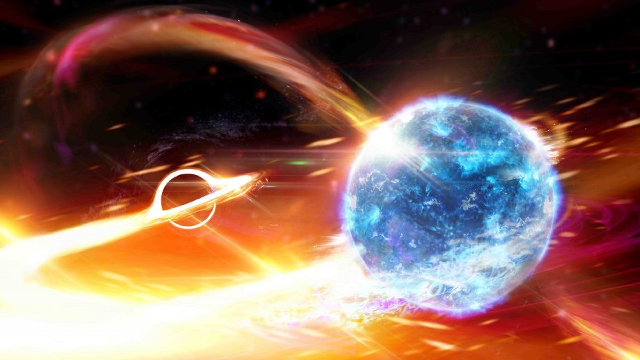In a world-first, scientists believe they have detected a black hole swallowing a neutron star – an event that happened 8,550 million trillion kilometres from Earth.
This fascinating article would be best suited to year 10 students studying Earth and Space Sciences. It could also be used with students in years 7, 8, 9, 10, 11, and 12 studying Chemical, Earth and Space and Physical Sciences.
Word Count: 377

A worldwide collaboration of scientists, including from The Australian National University (ANU), say they may have detected a black hole eating a neutron star for the first time.
If that wasn’t impressive enough, the cataclysmic event was detected about 8,550 million trillion kilometers from Earth.
Neutron star snuffed out instantly
Susan Scott, from the ANU Research School of Physics, says the achievement completed the team’s trifecta of observations on their original wish list, which included the merger of two black holes and the collision of two neutron stars.
Neutron stars and black holes are the super-dense remains of dead stars.
“About 900 million years ago, this black hole ate a very dense star, known as a neutron star, like Pac-man – possibly snuffing out the star instantly,” says Scott.
“It was a very clear and loud signal,”Scott told the ABC.
Based on the results the scientists can only label the collision as a gravitational-wave candidate. However, initial analysis of the masses of the objects indicates it could well be a neutron star-black hole binary.
“We have to do some more checking of the data and signal to be absolutely certain but it is looking quite probable.”
“The ANU SkyMapper Telescope responded to the detection alert and scanned the entire likely region of space where the event occurred, but we’ve not found any visual confirmation,” says Scott of follow-up studies being carried out.
The final results are expected to be published in scientific journals.
Very slight possibility that the swallowed object could be a black hole
“Scientists have never detected a black hole smaller than five solar masses or a neutron star larger than about 2.5 times the mass of our Sun,” Scott says.
“Based on this experience, we’re very confident that we’ve just detected a black hole gobbling up a neutron star.
“However, there is the slight but intriguing possibility that the swallowed object was a very light black hole – much lighter than any other black hole we know about in the Universe. That would be a truly awesome consolation prize.”
Login or Sign up for FREE to download a copy of the full teacher resource





